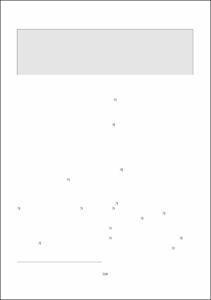여성 골반 종괴의 자기공명영상에서 장내 조영제의 유용성
- Keimyung Author(s)
- Kim, Jung Sik; Kim, Hong; Sohn, Chul Ho; Lee, Hee Jung; Lee, Sung Mun; Woo, Seong Ku; Suh, Soo Jhi
- Department
- Dept. of Radiology (영상의학)
- Journal Title
- 대한방사선의학회지
- Issued Date
- 1999
- Volume
- 41
- Issue
- 3
- Abstract
- 목적 : 여성 골반 종괴들의 자기공명을 이용한 영상진단에서 장내 조영제의 유용성을 알아보고자 하였다.
대상 및 방법 : 1 9 9 8년 4월부터 7월까지 골반종괴로 자기공명영상을 시행한 1 6명의 환자들을 대상으로 하였다. 대상환자들의 병변의 기원은 난소가 1 2예, 자궁이 3예, S-자 결장이 1예 이었다. 자기공명영상은 1 .5T 자기공명영상장치 및 체표면 코일을 사용하였고 항문으로 300 - 1000ml의 Magnevist Enteral (Shering, Berlin, Germany)을 주입한 후 스핀에코(SE) T1과 터보 스핀에코(TSE) T2 강조영상 그리고 2차원 Fast low Angle Shot(FLASH 2D), Half-Fourrier TSE(HASTE) 영상을 각각 얻었다. 이들 영상은 장내 조영제 주입 전 T1, T2 강조영상과 비교하였다. 판독은 2명의 방사선과 전문의가 합의 하에 1 )병변과 주위 장과의 구분정도(1, 구분 않됨; 2, 부분적으로 구분; 3, 명확히 구분) 2)인공 음영 발생 빈도(0, 없음; 1, 경미함; 2, 심함) 3)영상의 질(1, 나쁨; 2, 보통; 3, 좋음)등을 각각 등급으로 나누어 비교하였으며 Wilcoxon signed ranked test를 이용하여 통계적 유의성이 있는지를 알아 보았다. 또한 장내 조영제 사용 후 진단의 변화 유무도 알아 보았다.
결과 : 병변의 구분 정도는 장내 조영제 주입 후 얻은 스핀에코 T1 강조영상과 2차원 FLASH T1 강조영상이 조영 전 스핀에코 T1 강조영상보다 우월하였으며(p<0.05), 영상의 질은 장내 조영제 주입후 호흡정지 기법으로 얻은 2차원 FLASH T1 강조영상과 HASTE 영상이 조영 전 터보 스핀에코 T1, T2 강조영상보다 의의있게 좋았다(p<0.05). 인공 음영의 발생은 고식적 자기공명영상에서는 장내 조영제 주입 후 증가하였으나 호흡정지 기법에서는 전례에서 발생하지 않았다. 장내 조영제 주입 후 진단이 변한 것은 2예에서 관찰되었다.
결론 : 골반 종괴를 가지는 부인과 환자들에서 장내 조영제는 호흡정지 기법을 이용한 고속 자기공명영상을 사용하였을때 병변의 발견과 영상의 질 그리고 진단의 정확성을 높일 수 있으리라 사료된다.
Purpose : To assess the value of enteral contrast media for the evaluation of pelvic masses by MR imaging.
Materials and Methods : Between April and July 1998, 16 women with pelvic masses were examined by MRI. The origin of the lesion was the ovary in twelve cases, the uterus in three, and the sigmoid in one. Using a 1.5T scanner(Magnetom Vision, Siemens), T1-weighted axial spin echo(SE), T2-weighted turbo spin echo(TSE), twodimensional fast low-angle shot(FLASH 2D), and half-Fourier TSE(HASTE) images were obtained in all patients after the administration of Magnevist Enteral (Shering, Berlin, Germany). In each MR imaging sequence, distinction between the lesion and adjacent bowel (1, not distinguished; 2, partly distinguished; 3, clearly distinguished), artifact (0, absent; 1, mild; 2, severe), image quality (1, poor; 2, fair; 3, good), were compared before and after the use of enteral contrast media. Changes in MRI impression after the use of enteral contrast media were also evaluated. Two radiologists reached a consensus after reviewing the images. Statistical significance was determined by Wilcoxon’s signed ranked test.
Results : For distinguishing lesions, SE T1WI and FLASH 2D with enteral contrast media were significantly superior to SE T1WI without enteral contrast media (p<0.05). With regard to image quality, FLASH 2D and HASTE, both with enteral contrast media, were significantly superior to SE T1WI and TSE T2WI, respectively, both without enteral contrast media (p<0.05). Artefacts were more frequently found after the application of enteral contrast media in conventional sequences but were not present in breathhold sequences. In two patients, MRI impression changed after the appilication of enteral contrast media.
Conclusion : In a limited number of cases, enteral contrast media improved lesion detection, image quality and diagnostic accuracy when breathhold fast MR imaging was applied.
Index words :Pelvis, MR Pelvis, Neoplasms Contrast media, MR
- Alternative Title
- Usefulness of Enteral Contrast Media in
MR Evaluation of Pelvic Mass
- Publisher
- School of Medicine
- Citation
- 김훈 et al. (1999). 여성 골반 종괴의 자기공명영상에서 장내 조영제의 유용성. 대한방사선의학회지, 41(3), 559–564. doi: 10.3348/jkrs.1999.41.3.559
- Type
- Article
- ISSN
- 0301-2867
- Appears in Collections:
- 1. School of Medicine (의과대학) > Dept. of Radiology (영상의학)
- 파일 목록
-
-
Download
 oak-bbb-1013.pdf
기타 데이터 / 320 kB / Adobe PDF
oak-bbb-1013.pdf
기타 데이터 / 320 kB / Adobe PDF
-
Items in Repository are protected by copyright, with all rights reserved, unless otherwise indicated.